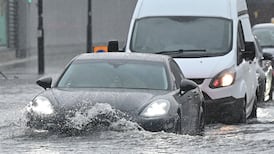It is almost impossible to escape the stench of decomposing bodies in Banda Aceh. It has enveloped the city on the northern tip of Sumatra like a sticky slime, carried on the wind to even the few places which survived last Sunday's devastating earthquake and tsunami.
Five hundred soldiers are working from dawn to dusk to try to clear the corpses. Around the city, work parties clad in rubber gloves and masks are using anything they can to complete their grim task.
Most teams have run out of body bags and have no proper equipment to lift the corpses, so they are using debris from the street to lever the remains on to black plastic sheeting and trussing them up like parcels ready for posting.
No attempt is made to identify them. They are just dumped 30 at a time on trucks and taken off to one of several mass graves that are being dug just outside the city. No one has any idea how long the task will take because no one has any idea how many bodies there are.
"If one looks at where the population lived and where the destruction is, the more densely populated areas got hit much worse," Col T. Syahrul said while assessing a mound of about 200 corpses which have gathered in the Kreung Aceh river under the Peunayong bridge, a couple of miles in from the coast.
"The population of the city is 400,000 so I would guess the death toll in the city alone is 100,000."
Scanning the city from the bridge, it is hard to disagree. So far 26,000 bodies have been counted but everyone believes that is just the tip of the iceberg.
For example, the districts between the Peunayong bridge and the coast, Kedah and Java Village, have been completely flattened to debris just a few inches high - with the exception of the odd tree or house which inexplicably survived the quake and then the tidal waves.
Buried deep within this debris are almost certainly thousands of bodies which will probably never be found.
The occasional limb sticking up through the fetid mud gives the only clue to the natural grave created under the rubble.
Each day dozens of people traipse through the wreckage, hoping for a miracle, that their missing loved ones will somehow turn up alive. A few covered their faces in coffee grounds to cover the stench of death.
"I know it looks stupid," said Muhammed Abdullah, looking for his son and daughter-in-law, "but it's effective."
Naman Nasaruddin accepts that he is probably wasting his time. "So far 19 of my family have died and only nine survived," said the teacher, who was at his home in Kedah when disaster struck.
"The water came from two directions so we had only one way to run as the river blocked the other way out. It was well over 10 metres high," he said.
"We all ran as fast as we could but we couldn't get far. I was hanging on to my four-year-old daughter but the force of the water was so great she was ripped from my hands."
The prisoners in the jail next to where Mr Naman eventually took refuge had no chance to escape. The tortured expressions on their faces starkly demonstrated how particularly unpleasant their deaths must have been.
Some hands were clenched into fists, as if they were banging on their cell walls when disaster struck. Others had clearly been screaming but it is unlikely anyone heard their pleas, let alone was in a position to do anything.
Most residents are measuring the time it will take to rebuild in years. The vice president, Mr Jusuf Kalla, estimated five years when he visited the city earlier this week and few people are disagreeing.
Many districts along the road heading south-west out of town towards Meulaboh - the town nearest the epicentre - are, if it is possible, even more badly devastated than Kedah and Java Village.
Whole neighbourhoods are now looking more like rice fields than housing estates, while the fields in which rice once grew now resemble lakes, complete with vehicles sticking up in them and corpses floating around.
But even the survivors here know that Banda Aceh is not the worst-affected part of the province. That dubious honour belongs to the west coast from the provincial capital down through Meulaboh and on towards Tapaktuan.
Proof of this was given by Asri Achmad, an irrigation engineer who was evacuated by helicopter yesterday from Lhoong sub-district, about 30 miles from Banda Aceh.
"Of 28 villages in the sub-district, only four are left," he said after arriving at Banda Aceh airport. "Before the earthquake the population was 12,322. Of those, 9,230 were killed."
These deaths are among those that have taken the official Indonesian toll to 79,000.
Mr Asri said the earthquake lasted about 15 minutes. "When that finished there was a noise like a bomb. Then a gap, then a noise like a ship's engine and then people started screaming," he said.
"Everyone started running with the water about 30 metres behind them. Many slipped and fell before they got to high ground. The water simply sucked them up and they disappeared. The water kept going for about 5 km. Everything was destroyed. All the buildings were flattened."
After the water level dropped, water gathered in menacing-looking ponds. "The water was black in many areas," he said. "I reckon this means these ponds were full of bodies."
In neighbouring areas, the scale of the devastation was even greater, according to Mr Mike Griffiths, an environmentalist who flew along the west coast three days ago to assess damage to the region's eco-system.
"For example, there were four towns of 10,000 people each where there was absolutely nothing standing and no one alive, except for one place where we saw 30 people huddled around a telephone transmitting tower," he said. "It looked like a brown wasteland extending 2 km back from the beach."
"The situation in Meulaboh itself is little better," said Ms Epayani, whose family yesterday were the first people to be evacuated from the town where the destruction rate was about 80 per cent and the death toll is expected to reach tens of thousands.
"I don't know how we survived," she said on arrival at Banda Aceh airport. "My house was flattened, it's just water now. Many, many houses are the same." She believes many thousands of people were killed in the town.
"There are so many bodies lying around. Some have been gathered into piles but many are just there in the open."
Amid the uncountable tales of tragedy there is an occasional astonishing survival story, such as that of Ms Epayani's nine-year-old son, Wira Dwi Lesmana.
When the waves swamped Meulaboh, the family climbed a tree and scrambled on to the roof of their one-storey house.
"Wira fell off and into the water," Ms Epayani said. "He climbed on to a cupboard but that soon began to sink too. He then clambered on to a mattress and I watched him drift out to sea. I was screaming and I heard him calling 'Mama, Mama'."
The mother understandably feared for the worst but two days later the two were reunited at the town's military base.
"I cannot tell you how happy I was to see him," she said. "Wira was on that mattress for two days without any food and water. He eventually climbed on to a passing ferry and was brought back here."
The family's evacuation is evidence that after a very slow start, the emergency relief operation is starting to gather pace. Singapore, Australia, New Zealand and Malaysia have all contributed aircraft and flights are now running round the clock.
"The bottleneck is in the distribution once the aid gets here," Indonesia's air force chief Gen Chappy Hakim said during an inspection visit yesterday. "We need more trucks to deliver the supplies and more helicopters."
Commanders are unwilling to predict how long the operation will last.
"Before I arrived I thought it would be about three months, but now I am not sure," said Maj Gen Bambang Darmono, who is in charge on the ground in Aceh.





